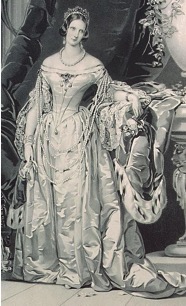Victorian fashion







Victorian fashion refers to the clothing styles that were popular in Great Britain and the British Empire during the reign of Queen Victoria, from 1837 to 1901. This period saw significant changes in fashion, influenced by the Industrial Revolution, social changes, and the expansion of the British Empire.
Overview[edit]
Victorian fashion is characterized by its elaborate and ornate designs, with a focus on modesty and propriety. The clothing styles evolved significantly over the decades, reflecting changes in society, technology, and cultural influences.
Women's Fashion[edit]
Early Victorian Era (1837-1856)[edit]
During the early Victorian era, women's fashion was marked by large, full skirts supported by crinolines and petticoats. Bodices were tight-fitting with narrow sleeves, and necklines were often high. The silhouette was hourglass-shaped, emphasizing a small waist.
Mid-Victorian Era (1857-1876)[edit]
The mid-Victorian era saw the introduction of the crinoline cage, which allowed skirts to become even fuller without the need for multiple petticoats. By the late 1860s, the crinoline began to fall out of favor, replaced by the bustle, which added volume to the back of the skirt.
Late Victorian Era (1877-1901)[edit]
In the late Victorian era, the bustle became more pronounced, and skirts were often draped and layered. The Aesthetic Movement influenced fashion, promoting simpler, more natural styles. By the 1890s, the bustle had disappeared, and skirts became more streamlined. Sleeves grew larger, leading to the "leg of mutton" sleeve style.
Men's Fashion[edit]
Men's fashion during the Victorian era was characterized by a more conservative and formal style. The frock coat was a staple of men's wardrobes, along with waistcoats and trousers. In the 1850s, the morning coat became popular for daytime wear, while the tailcoat was reserved for evening occasions. By the late Victorian era, the sack suit had become the standard for men's daywear.
Children's Fashion[edit]
Children's fashion in the Victorian era mirrored adult styles but was often more practical. Boys typically wore sailor suits or Eton suits, while girls wore dresses with full skirts and petticoats. As children grew older, their clothing became more similar to adult fashion.
Accessories[edit]
Accessories played a significant role in Victorian fashion. Women often wore bonnets, gloves, and parasols, while men accessorized with top hats, bowler hats, and walking sticks. Jewelry was also important, with items such as brooches, cameos, and lockets being popular.
Related Pages[edit]
- Queen Victoria
- Industrial Revolution
- Aesthetic Movement
- Crinoline
- Bustle
- Frock coat
- Morning coat
- Tailcoat
- Sack suit
- Sailor suit
- Eton suit
Categories[edit]
Ad. Transform your life with W8MD's Budget GLP-1 injections from $75


W8MD offers a medical weight loss program to lose weight in Philadelphia. Our physician-supervised medical weight loss provides:
- Weight loss injections in NYC (generic and brand names):
- Zepbound / Mounjaro, Wegovy / Ozempic, Saxenda
- Most insurances accepted or discounted self-pay rates. We will obtain insurance prior authorizations if needed.
- Generic GLP1 weight loss injections from $75 for the starting dose.
- Also offer prescription weight loss medications including Phentermine, Qsymia, Diethylpropion, Contrave etc.
NYC weight loss doctor appointmentsNYC weight loss doctor appointments
Start your NYC weight loss journey today at our NYC medical weight loss and Philadelphia medical weight loss clinics.
- Call 718-946-5500 to lose weight in NYC or for medical weight loss in Philadelphia 215-676-2334.
- Tags:NYC medical weight loss, Philadelphia lose weight Zepbound NYC, Budget GLP1 weight loss injections, Wegovy Philadelphia, Wegovy NYC, Philadelphia medical weight loss, Brookly weight loss and Wegovy NYC
|
WikiMD's Wellness Encyclopedia |
| Let Food Be Thy Medicine Medicine Thy Food - Hippocrates |
Medical Disclaimer: WikiMD is not a substitute for professional medical advice. The information on WikiMD is provided as an information resource only, may be incorrect, outdated or misleading, and is not to be used or relied on for any diagnostic or treatment purposes. Please consult your health care provider before making any healthcare decisions or for guidance about a specific medical condition. WikiMD expressly disclaims responsibility, and shall have no liability, for any damages, loss, injury, or liability whatsoever suffered as a result of your reliance on the information contained in this site. By visiting this site you agree to the foregoing terms and conditions, which may from time to time be changed or supplemented by WikiMD. If you do not agree to the foregoing terms and conditions, you should not enter or use this site. See full disclaimer.
Credits:Most images are courtesy of Wikimedia commons, and templates, categories Wikipedia, licensed under CC BY SA or similar.
Translate this page: - East Asian
中文,
日本,
한국어,
South Asian
हिन्दी,
தமிழ்,
తెలుగు,
Urdu,
ಕನ್ನಡ,
Southeast Asian
Indonesian,
Vietnamese,
Thai,
မြန်မာဘာသာ,
বাংলা
European
español,
Deutsch,
français,
Greek,
português do Brasil,
polski,
română,
русский,
Nederlands,
norsk,
svenska,
suomi,
Italian
Middle Eastern & African
عربى,
Turkish,
Persian,
Hebrew,
Afrikaans,
isiZulu,
Kiswahili,
Other
Bulgarian,
Hungarian,
Czech,
Swedish,
മലയാളം,
मराठी,
ਪੰਜਾਬੀ,
ગુજરાતી,
Portuguese,
Ukrainian
